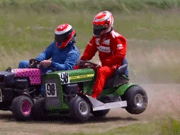
Rider Mower

Riding mowers racing began in the 1960s as a form of novelty. Since that time they have grown into a serious form of low-cost racing.
Rider Mowers typically used for racing have the cutting blades removed, the CG height lowered and the transmission geared up to give speeds of approximately 45 mph (72 km/h). To keep the racing low-cost, entry-level classes retain many stock components while most open classes allow customization of the powertrain and chassis.
Racing is generally held on small dirt tracks to keep the racing competitive and close. Racing takes place in the Americas, Europe and Australia.
| Power and Weight Stats | |
| Horsepower (Typical Range) | 10-50 |
| Race Weight (Typical Range) | 204-272 kg 450-600 lb |
Design and Construction
Race Car Models of This Type
There are numerous models of stock mowers that qualify for racing or as a donor for a customized machine.
Build Your Own Rider Mower
Knowledge Level
Rider mower racing does not permit extensive modifications in the entry-level classes, so a basic working knowledge of handling is useful. As you develop your mower into more of a purpose-built racing machine, it will be helpful to have a working knowledge of powertrain and chassis, as most modifications will center around these areas. In addition to a small engine repair manual, it will be useful to have resources around customizing the transaxles.
Design Challenges
Weight Distribution: The rider mower's weight is relatively well distributed front/rear with it being a front engine/rear drive short wheelbase machine.
For racing purposes, the lower the CG (Center of gravity) the better, but there are limits to seat height as well as chassis and mower deck ground clearance.
Suspension: There is generally no suspension allowed on rider mower racers. Tires provide the absorption of bumps and their types and pressures are usually regulated. Rear axle and front wheel brakes are worth consideration. Brakes other than that provided by a transaxle are required in the top classes.
Widths of the machines are regulated, but using the maximum allowed width will generally give the best handling. The exception perhaps is in situations where there is very little grip (such as a slick wet surface). In this case, narrower tires and track width could be helpful in getting corner "bite".
Throttle, brake and clutch controls are critical to smooth operation of the mower. The most natural configuration for you is the one to build. Some designs use a hand throttle attached the steering wheel, while others use traditional "car-like" pedal arrangements. In the case where a hydraulic disc brake is used, there will need to be separate clutch actuation because many rider mowers combine the brake and clutch into one pedal.
Chassis: Depending on the class, modifications may be made to the chassis and body work. Modifications might include strengthening a weak chassis, altering CG if allowed, changing the wheelbase if allowed, and welding the front suspension as a fixed beam.
Powertrain: Using aftermarket filters and racing exhaust may be a consideration if permitted by the regulations. Modifications must be made to stock transaxle gearing for higher speeds to be reached. Most transaxles have a limit to the input RPM, and so adjusting the gearing inside the transaxle enables output speeds to be increased. In top classes the powertrain regulation is open so far more flexibility is available in final drive configuration (ie. Centrifugal clutches, Chain drive, live axle)
Safety: Consideration should be given to securing critical fasteners with locking mechanisms (Castellated nuts, safety wire, cotter pins, etc.) to prevent failures of brakes, loss of wheels, or drivetrain components. A spring-loaded "throttle close" system should be included to close the throttle in case of a control cable failure. An ignition kill switch should also be included to quickly kill the motor in an emergency.
If you intend to race under a sanctioning body, always read and understand the regulations of your chosen racing class before designing or building any race vehicle.
Design Resources
Learn the basics about race cars and race car design from our free online knowledge series
Download our free race car design aids to assist you designing your race vehicle.
In-depth books and learning resources we recommend for rider mower design.
Join our forum to ask and find answers to your rider mower design/construction questions.
Construction Challenges
Having sufficient space around your mower for the build is important, as a cramped workshop can be difficult to work in.
The tools to modify the chassis (ie. welder, metal working) can add considerably to the cost of your project if you don't already have a workshop, but borrowing or renting items is also an option.
Build Costs
Donor mowers can be had used for low prices, provided the state of the engine and transmission is still good. Because of the limited size and power, most parts are OEM or fairly low cost to fabricate.
Build Effort
Due to the unique nature of each rider mower brand and model line, modifications will usually require OEM/off-the-shelf part replacements. Customizing beyond that will require metal working or creative part scrounging.
Racing Cost
Very, very low. Tire replacement, except in the case of damage is infrequent.
Transportation and Support Equipment
Can be loaded into the back of a pickup truck or onto a small trailer. Support equipment can be carried in the transport vehicle.

